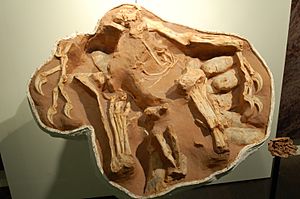Citipati facts for kids
Quick facts for kids Citipati |
|
|---|---|
 |
|
| Nesting C. osmolskae specimen nicknamed "Big Mamma", housed at the AMNH | |
| Scientific classification | |
| Genus: |
Citipati
|
| Species: |
osmolskae
|
Citipati (say "SIT-ih-pah-tee") was a type of dinosaur that lived a very long time ago. Its name comes from Hindi and means 'funeral pyre lord'. This dinosaur was a theropod, which means it walked on two legs like a bird. It belonged to a group called oviraptorids.
Citipati lived during the Late Cretaceous Period. This was about 84 to 75 million years ago! Its fossils have been found in what is now Mongolia. The most well-known type of Citipati is called Citipati osmolskae. Scientists officially described it in 2001. There might even be another type of Citipati that hasn't been named yet. People sometimes mix up Citipati with another similar dinosaur called Oviraptor.
Contents
Meet Citipati: A Bird-Like Dinosaur
Citipati was a fascinating dinosaur with many features similar to modern birds. It had a short, deep skull and a beak without teeth. Its body was covered in feathers, just like birds today.
What Did Citipati Look Like?
Citipati was about the size of a large emu or ostrich. It stood around 2.5 to 3 meters (8 to 10 feet) tall. Its long, slender legs helped it run fast. It also had strong arms with sharp claws. These claws might have been useful for digging or for holding onto things.
The Famous "Big Mamma" Specimen
One of the most famous Citipati fossils is nicknamed "Big Mamma." This amazing fossil shows an adult Citipati sitting on a nest of eggs. It was found in a nesting pose, just like a bird incubating its eggs. This discovery gave scientists important clues about how these dinosaurs cared for their young. It showed that some dinosaurs had behaviors very similar to birds.
Nesting Habits of Citipati
The "Big Mamma" fossil proved that Citipati was a caring parent. The dinosaur was found with its arms spread over the eggs, protecting them. This nesting behavior is called brooding. It suggests that Citipati kept its eggs warm and safe until they hatched. This is a big reason why scientists believe dinosaurs and birds are closely related.
Where Did Citipati Live?
Citipati lived in the Gobi Desert region of Mongolia. This area was very different millions of years ago. It had rivers, lakes, and forests, not just sand. Many other dinosaurs also lived there, including other oviraptorids and even some early mammals.
What Did Citipati Eat?
Scientists are still not completely sure what Citipati ate. Its beak-like mouth and lack of teeth suggest it might have eaten plants, eggs, or small animals. Some scientists think it might have been an omnivore, meaning it ate both plants and meat. The name "oviraptorid" means "egg thief," but this name was given by mistake. The first Oviraptor fossil was found near a nest of eggs, and scientists thought it was stealing them. Later, they realized the eggs actually belonged to the Oviraptor itself!
Images for kids
-
Mounted IGM 100/42; this specimen has been largely used as a reference for Oviraptor and could represent a second species of Citipati
See also
 In Spanish: Citipati osmolskae para niños
In Spanish: Citipati osmolskae para niños










